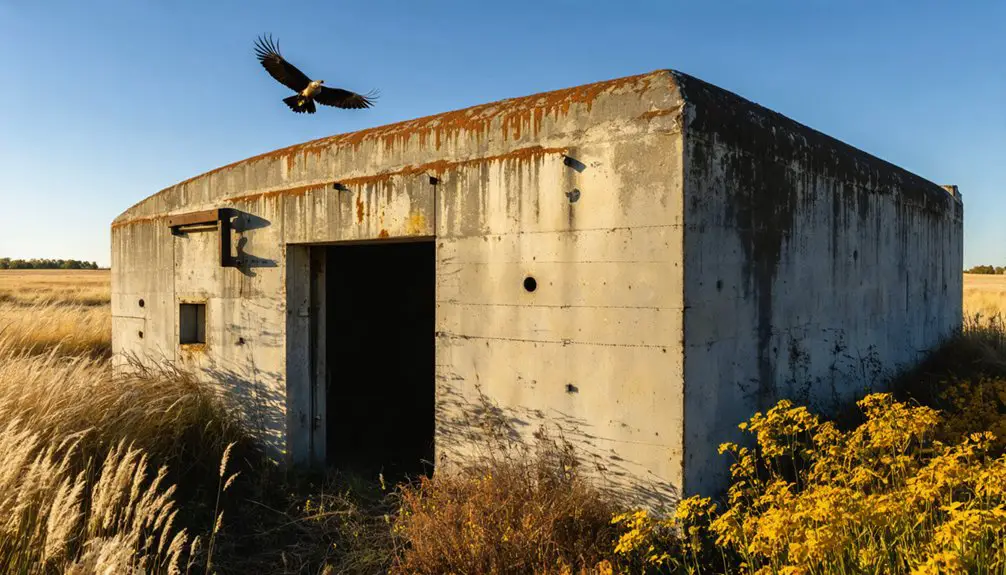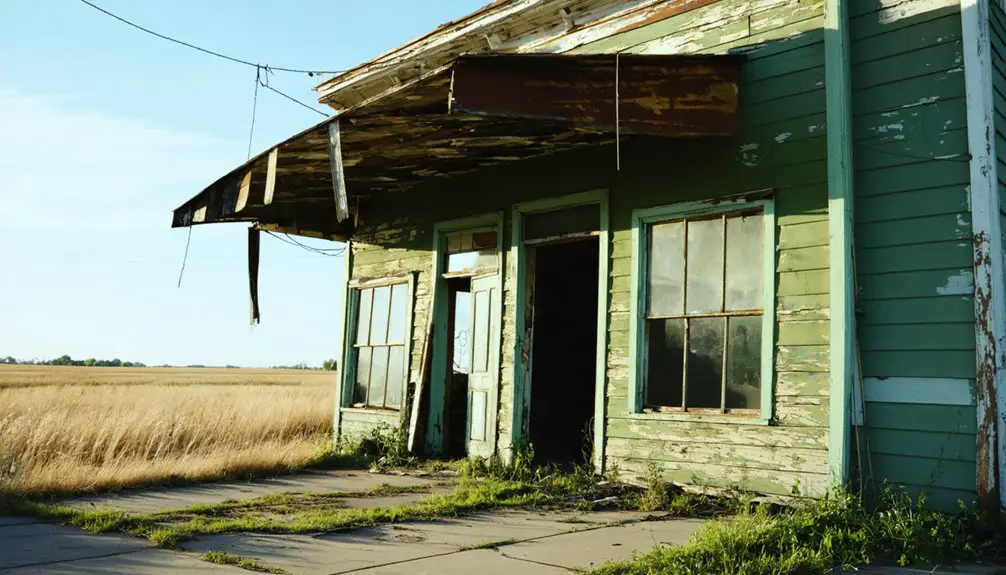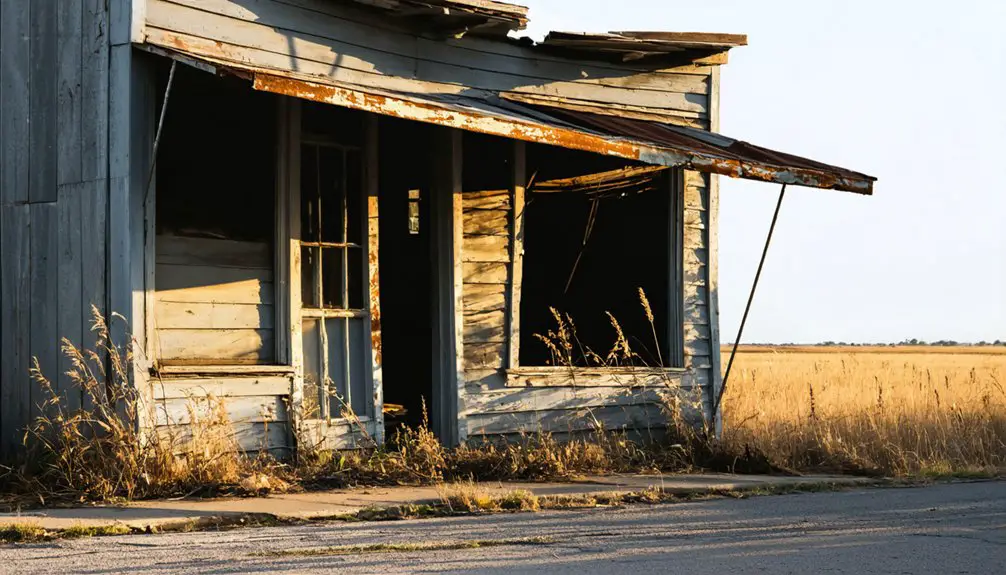You’ll find Bushong nestled along Kansas’s Flint Hills Trail, a unique ghost town named after St. Louis Browns catcher Albert “Doc” Bushong in 1887. Once a thriving railroad hub with 250 residents, the town peaked in the 1920s before declining after a devastating fire and the 1957 closure of its railroad depot. Today, about 30 residents remain among preserved structures, including a bank vault and the iconic blue water tower, while its baseball origins and Cold War missile silo tell fascinating tales.
Key Takeaways
- Bushong, Kansas is a well-preserved ghost town with approximately 30 current residents, down from its peak of 250 in 1910.
- A devastating fire in the 1920s and the closure of the railroad depot in 1957 led to the town’s significant decline.
- Original structures including a boarded-up bank vault and intact sidewalk systems remain visible, making it historically significant.
- The town’s transformation into a ghost town accelerated during the Great Depression and continued through post-World War II economic changes.
- The Flint Hills Trail now runs through Bushong, preserving the former Missouri Pacific Railroad corridor for historical tourism.
The Birth of a Baseball-Inspired Town
While many towns emerged along railroad lines in late 19th century Kansas, Bushong’s origin stands uniquely tied to America’s pastime.
You’ll find this town’s baseball history woven into its very foundation. Originally named Weeks after Joseph Weeks, who donated 20 acres for the railroad station in 1886, the town was renamed Bushong on January 31, 1887.
The Missouri Pacific Railroad chose to honor the St. Louis Browns’ catcher Albert J. “Doc” Bushong, who’d helped clinch the 1886 World Series against the Chicago White Stockings. His exceptional skills behind the plate helped him catch 106 games that season.
The railroad’s town naming strategy celebrated several Browns players across Kansas, but today, only Bushong remains as a tribute to that historic championship.
It’s a distinctive piece of baseball history preserved in the Kansas landscape. The town’s early growth was marked by a population of 250 by 1910.
Railroad Glory Days and Economic Peak
The Missouri Pacific Railroad’s arrival in 1886 sparked Bushong’s transformation from empty prairie to bustling transport hub.
You’d have seen railroad expansion reshape the landscape, with a large tank pond built east of town to supply steam engines and cattle pens constructed to handle livestock shipments. The railroad’s stone quarry south of town kept the tracks busy with shipments to Kansas City. Originally named Weeks, the town became Bushong in 1886.
During this period of economic growth, you’d have found a thriving community centered around the depot. The town boasted a two-story school, post office, and various businesses serving railroad workers and cattle operations. The town was named after Samuel Theodore Bushong, who founded the Bushong Candy Company in Wichita.
While many platted lots remained vacant, the population swelled to several hundred as the railroad’s presence attracted new residents and commercial ventures, making Bushong a crucial link in the region’s transportation network.
Educational Heritage and Community Life
You’ll find that Bushong’s educational legacy began with its first schoolhouse in 1886, a two-story wooden structure that served grades 1-8 for over six decades.
The school’s significance extended beyond basic education, as it functioned as an essential community gathering place where local identity and social bonds were forged. Today, visitors can still see the school’s stone staircase among the remaining ruins. The town’s name honors former MLB catcher Albert Bushong, who played for the Cleveland Blues and St. Louis Browns.
When students changed to a new brick high school in 1948, it marked both educational progress and the town’s modernization efforts, though this advancement would eventually give way to regional consolidation as Bushong’s population declined.
School Evolution Timeline
As Bushong emerged alongside the Missouri Pacific Railroad in 1886, educational development quickly became a cornerstone of community life with the construction of its first school – a two-story wooden structure serving grades 1-8.
You’ll find the town’s education evolution marked by significant milestones, starting with the 1918 construction of Bushong High School, which initially featured four classrooms. A heated community dispute preceded the school’s establishment, with initial votes showing strong opposition before a special election finally approved the district.
The high school expanded in 1926 with the addition of a prominent gymnasium, reflecting the community’s commitment to both academic and social growth.
The original school building continued serving students until 1948, when they transferred to the newer brick high school facility.
After this change, the historic wooden school building was sold and removed, symbolizing the end of an era in Bushong’s educational heritage.
Community Learning Legacy
Throughout Bushong’s developmental years, education served as more than just a system of learning – it became the heartbeat of community life and social cohesion.
The two-story wooden schoolhouse, built in 1886, anchored community engagement and educational outreach efforts that would shape the town’s identity for decades to come.
You’ll find three key elements that defined Bushong’s educational legacy:
- The school building served as a civic hub, hosting community functions beyond traditional classroom learning.
- Educational facilities mirrored the town’s economic significance, expanding and contracting with population shifts.
- The 1950s school consolidation marked a crucial change, reflecting broader alterations in rural Kansas communities.
Though the physical school buildings are gone, their impact on Bushong’s social fabric remains an indispensable part of the town’s story.
Like other Kansas towns such as Delphos, the school featured a distinctive belfry and bell that became a symbol of educational progress.
From Bustling Stop to Quiet Settlement
While Bushong initially flourished as a bustling railroad stop after its 1886 founding, the town’s journey from peak to decline tells a story common to many rural Kansas settlements.
During its heyday in the 1920s and 1930s, you’d have found a thriving community of around 150 residents supported by essential town characteristics like a bank, elevator, grocery stores, and a Methodist church.
The town’s decline began with a devastating fire in the 1920s that destroyed several businesses. The Great Depression‘s impact, followed by the significant 1957 closure of the railroad depot, accelerated the population decline. The town hosted Cold War missile complexes during its later years, marking a unique chapter in its history.
Today, you’ll find Bushong transformed into a quiet settlement with roughly 30 residents, its former railroad line now serving as the recreational Flint Hills Trail. The town was named after Albert J. Doc Bushong, a catcher for the St. Louis Browns baseball team.
Military Footprint During the Cold War

During the early 1960s, Bushong’s quiet landscape became an important part of America’s nuclear deterrence strategy when the military constructed one of nine Atlas E intercontinental ballistic missile silos near the town.
This remarkable piece of military history featured a massive 400-ton steel door and underground facilities designed to protect America’s nuclear arsenal.
You’ll find three key aspects that made Bushong’s missile site essential to national defense:
- Each Atlas E missile carried warheads 300 times more powerful than WWII atomic bombs
- The site maintained constant combat readiness during major Cold War events
- The silo’s strategic position complemented eight other sites protecting Topeka
Today, you can still explore the decommissioned silo, a stark reminder of when this small Kansas town played a significant role in defending American freedom.
Modern Transformation Into Trail Country
If you’re exploring Bushong today, you’ll find it’s been transformed by the 120-mile Flint Hills Trail, which repurposed the former Missouri Pacific Railroad corridor that once defined this small town.
The trail’s development in the 1990s preserved much of the original railroad infrastructure while creating new opportunities for outdoor recreation and historical tourism.
You can still spot remnants of Bushong’s railroad heritage along the trail, including the iconic blue water tower that serves as a landmark for hikers and cyclists passing through this quiet corner of Kansas.
Trail Development History
Since the late 1880s, the corridor that would become today’s Flint Hills Trail began as the Council Grove, Osage City & Ottawa Railway before evolving to Missouri Pacific Railroad ownership.
When rail service ended in the 1980s, Rails-to-Trails Conservancy stepped in to preserve this historic pathway for public use through railbanking.
The transformation into Kansas’s longest trail involved:
- Transfer of ownership to Kanza Rail-Trails Conservancy, ensuring local trail accessibility
- Extensive community involvement through volunteer labor and grassroots support
- Strategic development in phases, leveraging grants and donations for restoration
Despite initial resistance from some local governments and property owners, the trail project gained momentum through persistent advocacy and eventually earned state park status under Kansas Department of Wildlife and Parks management.
Railroad Heritage Preservation
The preservation of Bushong’s railroad heritage has evolved into a multifaceted effort spanning both physical infrastructure and cultural memory. You’ll find organizations like the Kaw Valley Rail Heritage Conservancy leading railroad restoration projects, particularly focusing on steam locomotives like Santa Fe 3463.
They’re maintaining these historic pieces while offering heritage education programs that highlight railroads’ social and economic impacts.
The town’s railroad legacy lives on through the Flint Hills Trail, which repurposes former Missouri Pacific Railroad corridors. You can explore remnants of the past, including the original tank pond and cattle pens, which stand as evidence to Bushong’s shipping history.
The town’s unique name, inspired by a 19th-century baseball player, reflects the Missouri Pacific Railroad’s lasting influence on local culture.
Preserving a Unique Kansas Legacy

While many Kansas ghost towns have faded into obscurity, Bushong stands as one of the state’s best-preserved reminders of its railroad-era past.
This remarkable ghost town preservation site offers you a unique glimpse into rural Kansas life during the late 1800s, with its boarded-up bank vault, abandoned storefronts, and visible sidewalk systems still intact.
Bushong’s cultural heritage significance stems from three distinct elements:
- It’s the only town named after a baseball player from the 1886 World Series champion St. Louis Browns.
- It holds Kansas’s highest per capita World War II death rate, with 10 casualties from just 134 residents.
- The North Lyon County Veterans’ Memorial complex preserves local military history through detailed stone markers and plaques.
You’ll find these historical treasures accessible via the Flint Hills Trail, though most structures remain private property requiring cautious exploration.
Frequently Asked Questions
What Types of Businesses Operated in Bushong During Its Peak Years?
You’d find this ghost town’s commerce centered around railroad operations, general stores, hardware shops, quarries, cattle shipping facilities, the Pacific House hotel, and historical landmarks like schools and drugstores.
Are There Any Remaining Original Buildings Still Standing in Bushong Today?
Amid crumbling brick and weathered stone, you’ll find a handful of historic structures still standing, including a bank vault, partial school walls with visible staircases, and scattered architectural preservation efforts on private property.
Which Famous People Besides Albert Bushong Have Connections to the Town?
You’ll find several historical figures connected to Bushong: Joseph Weeks, who donated the town’s original land, Charles Withington, an influential early settler, and Oliver Phillips, who served as a local legislator and county officer.
What Natural Disasters or Significant Events Have Impacted Bushong’s History?
You won’t find records of major tornado impacts or flood history affecting Bushong directly. The town’s decline stemmed from economic factors like railroad abandonment and the Great Depression rather than natural disasters.
How Did Local Native American Tribes Interact With Early Bushong Settlers?
By the 1870s, you’d find minimal interaction between settlers and Native Americans, as the Osage had already moved east. Trade relations and cultural exchange were nearly nonexistent in early Bushong’s development.
References
- https://legendsofkansas.com/bushong-kansas/
- https://www.youtube.com/watch?v=ie3zwwHm2Jg
- https://abandonedkansas.wordpress.com/2022/02/23/bushong-kansas/
- https://abandonedkansas.wordpress.com/2022/02/
- https://en.wikipedia.org/wiki/Bushong
- https://kids.kiddle.co/Bushong
- https://sabr.org/bioproj/person/doc-bushong/
- https://scholars.fhsu.edu/all_monographs/30/
- https://www.mlb.com/cut4/kansas-ghost-towns-named-after-st-louis-browns-players-c161501530
- https://simple.wikipedia.org/wiki/Bushong



